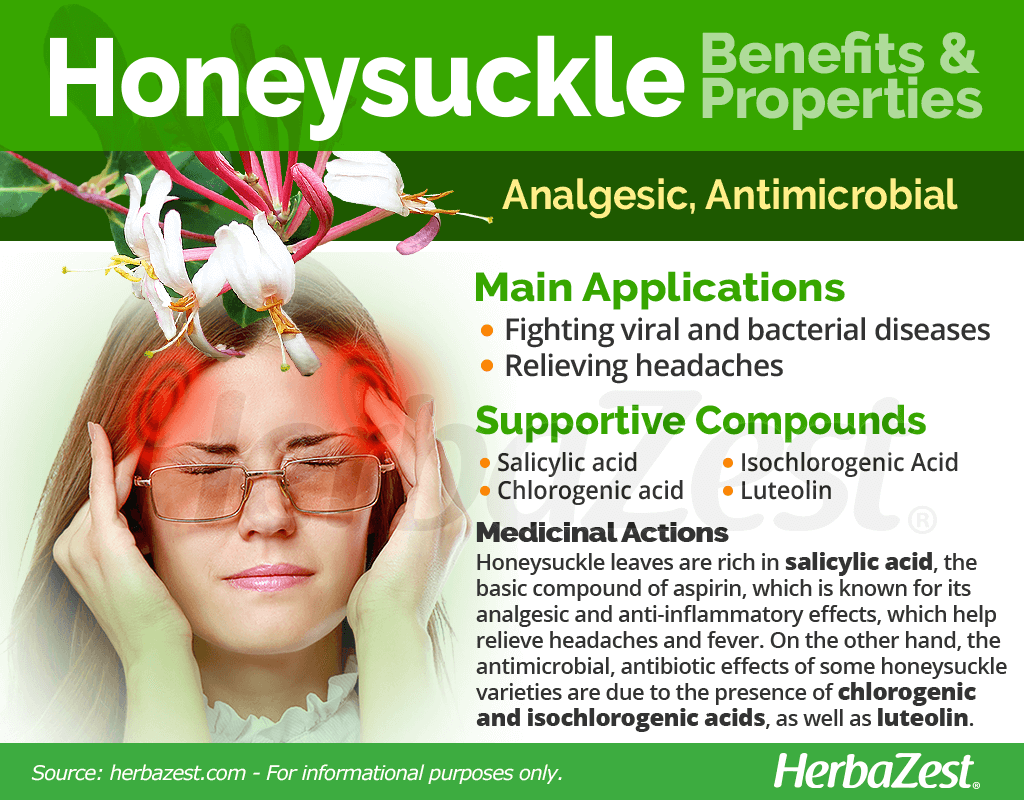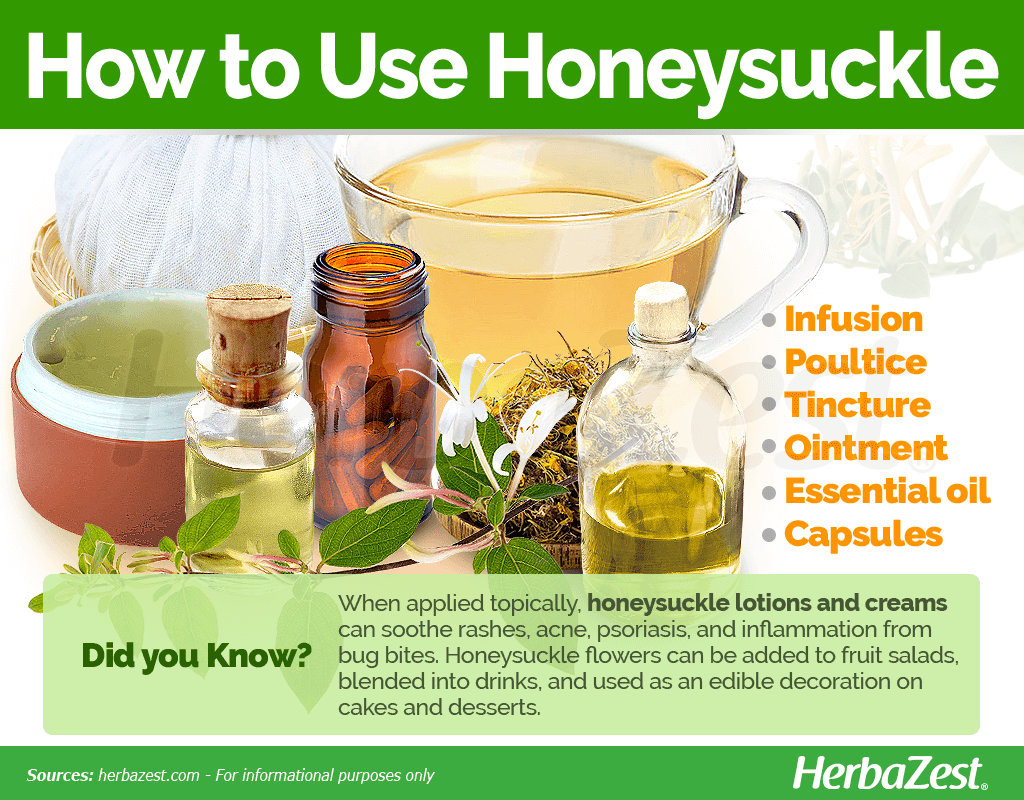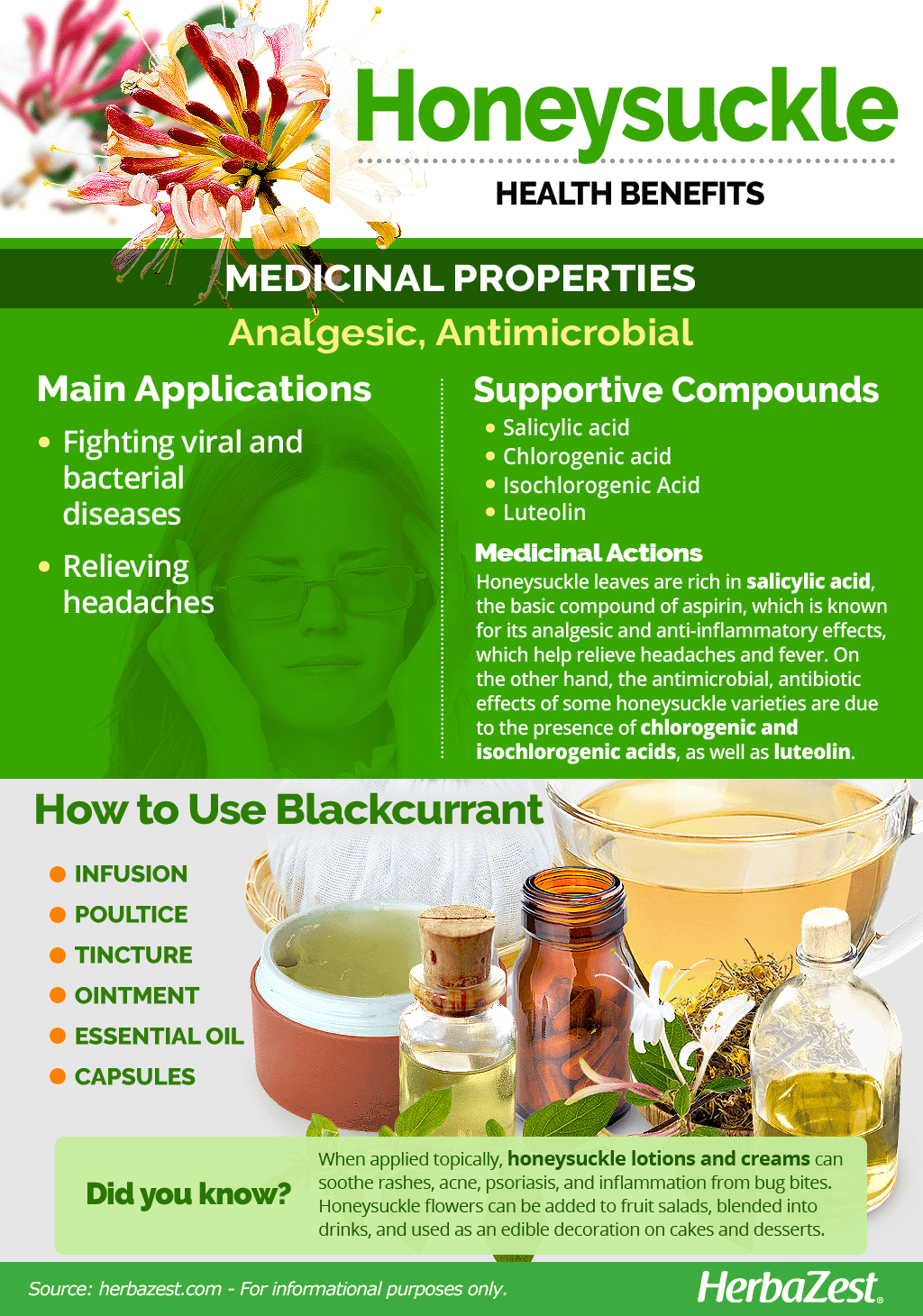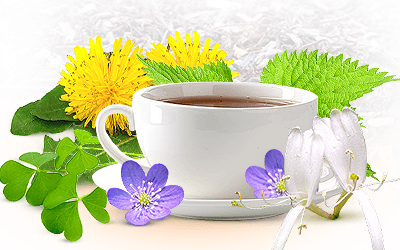Native to China, Japan, Korea, and far eastern Russia, honeysuckle was introduced to the West as an ornamental vine in the 19th century. Sought mainly for its strong, pleasant scent and its beautiful flowers, honeysuckle is also considered valuable for medicinal purposes.
Honeysuckle Medicinal Properties
- Medicinal action Analgesic, Antimicrobial
- Key constituents Salicylic Acid, Chlorogenic Acid, Luteolin and Isochlorogenic Acid
- Ways to use Capsules, Food, Tincture, Poultice, Ointment
- Medicinal rating (3) Reasonably useful plant
- Safety ranking Use with caution
Health Benefits of Honeysuckle
The Eastern countries where honeysuckle originated have been benefiting from the medicinal properties of the plant for many years. Some of the treatments recognized early on included those for urinary infections and respiratory discomfort. Modern research confirms that honeysuckle has a lot to offer in regards to health. Honeysuckle's benefits can be useful for:
Fighting viral and bacterial infections. Honeysuckle contains several antimicrobial components. This means that it can help combat the common cold as well as a wide range of bacteria, including Salmonella and Escherichia coli.
Relieving headaches. The leaves and flowers of honeysuckle contain a substance similar to aspirin, which can help dispel headaches and nausea.
Additionally, honeysuckle may help with:
Cooling body temperature. The cooling effects of honeysuckle can be beneficial to those suffering from menopausal hot flashes, fevers, sunstroke, and various infections.
Relieving irritated skin and acne. When it's applied topically in the form of a lotion or cream, the properties of the plant will quickly soothe rashes, psoriasis, and stings, as well as help to clear acne.
How It Works
Honeysuckle leaves and flowers contain a compound known as salicylic acid, an important component of aspirin, which has the ability to inhibit the production of pro-inflammatory lipids. This means that it can help reduce swelling and redness, as well as lower body temperature.
In Japanese honeysuckle, there are three main compounds that give the plant antibiotic effects. These are chlorogenic acid, luteolin, and isochlorogenic acid, all of which are present in the stem of the plant.1
Analgesic properties are also present in herbs like cayenne and cloves, whereas calendula can provide similar antimicrobial benefits.
Honeysuckle Side Effects
Overconsumption of honeysuckle is likely to have a laxative effect, which, in turn, can cause dehydration. The plant should be consumed in moderation, and supplements should only be taken as part of a healthy, balanced diet.
Honeysuckle Cautions
The berries produced by some species of honeysuckle are poisonous and should not be ingested.
Sufferers of sensitive skin might have a reaction to topical honeysuckle treatments. To avoid this, a skin test should be carried out before extensive use.
It is advised that women who are pregnant or breastfeeding check with a doctor before using honeysuckle preparations.

How to Consume Honeysuckle
- Edible parts Flowers, Leaves, Stem
- Edible uses Coloring, Beverage
Medicinal preparations are often the preferred method of consumption as they contain a more concentrated solution. These are made using the stem, leaves, and flowers.
Honeysuckle flowers are appearing in cooking more and more frequently. They can be added to fruit salads, blended into drinks, and used as an edible decoration on cakes and desserts.
The flowers contain a sweet nectar in the center, which can be sucked directly from the plant.
Natural Forms
Infusion. Honeysuckle tea is a popular option for those wanting to consume the plant in order to stave away colds and sore throats. The warmth and steam help to soothe and clear sinuses.
Poultice. This can be made by crushing the whole plant into a pulp and applying it directly to an inflamed or irritated area. It may be particularly useful in treating sore bites and stings.
Herbal Remedies & Supplements
Tincture. This preparation can be bought, but it is also easy to make at home. Tincture is a quick way to take advantage of the medicinal properties of honeysuckle. It can be diluted in water for drinking or used topically.
Ointment. This can be applied to skin to treat irritation and inflammation, helping to calm the affected area and reduce redness.
Oil. Honeysuckle can be bought in the form of an essential oil. This is favored in aromatherapy as it has a pleasant scent that is said to promote relaxation.
Capsules. Capsules are deemed to be a good option for those looking to relieve headaches or colds. They initiate a cooling effect to soothe these.

Growing
- Life cycle Perennial
- Harvested parts Flowers, Leaves, Stem
- Light requirements Full sun
- Soil Well-drained
- Growing habitat Temperate climates
- Pre-germination seed treatment None
- Planting time Early spring
- Plant spacing average 0.6 m (1.97 ft)
- Potential insect pests Aphids
- Potential diseases Powdery mildew
- Potential animal pests Birds
Honeysuckle is found in many different environments, and it is surprising how hardy the flower is considering its delicate appearance. Opinions differ on whether this plant is a pretty addition to gardens, or whether it is a nuisance weed. In fact, honeysuckle requires minimal attention and can be easily grown at home to be enjoyed as decoration or harvested for herbal remedies.
Growing Guidelines
Honeysuckle will grow in some shade, but full sun is optimal.
It will flourish best if regularly watered - soil should be kept moist.
A strong scaffold such as a trellis will help support the vine, encouraging the plant to spread.
Two inches (5 cm) of mulch on top of the soil is advisable in the winter months to protect the plant from frost.
Plants should be spaced two to three feet (60 - 90 cm) apart.
Honeysuckle can be cultivated indoors, but it will not flower.
Fertilizers are not essential, but will encourage growth.
More detailed information about growing honeysuckle can be found in our herb garden section.
Additional Information
- Other uses Dye, Perfume, Soapmaking
Plant Biology
The largest variety of honeysuckle is grown in China, but there are many species to be found elsewhere. It is a perennial evergreen climber, the vines of which reaching up to 20 feet (6.1 m). The stems, flexible and resilient, twist as they grow, which accounts for how the plant can spread across obstacles that come in its path. The honeysuckle flower, made up of thin petals that curl at the ends, is usually green-yellow or pink, and can be both male and female. However, only the female blossoms will produce fruit.
Classification
Honeysuckle belongs to the genus Lonicera, and it is also part of the Caprifoliaceae family, which comprises around 180 species across 11 genera. Up to 17 of these species are considered safe for human consumption; however, further scientific investigation is needed.
Related Species
Of the vast array of honeysuckle varieties, the most common ones to be utilized in food and for medicinal purposes are L. edulis, L. kamtchatica, L. altaica, L. boczkarnikovae, and L. japonica. Japanese honeysuckle (L. japonica) has been extensively studied, and it is said to be a diuretic and cleanser of the digestive system.
Historical Information
Honeysuckle was introduced to the United States in 1806. It first appeared as an ornamental plant and was also used for cosmetics due to its pleasant scent.
The genus name Lonicera was appointed by Lonicer, a 16th-century German physician who greatly promoted the herb for its medicinal value.
Popular Beliefs
In the 17th century, people associated honeysuckle with feelings of love and lust. This is apparent in Shakespeare's A Midsummer Night's Dream, in which the playwright uses the plant to suggest an image of lovers sleeping entwined together.
The twisted stem of the honeysuckle plant was once used to make walking sticks for men. It was said that these would help the user to find his perfect woman. It was once also believed that pouring a few drops of honeysuckle oil onto a pillow at night would give a person erotic dreams.
Other Uses
Aromatherapy. People make potpourri with the leaves and flowers, and also put the concentrated essence of the plant in candles, incense, perfume, soap, and assorted bath products.
Dye. The colorful flowers can also be used as a natural dye, in food or cosmetics.
Environmental support. The bright, nectar-filled blossoms attract wildlife, namely hummingbirds.
The sweet-smelling, pretty honeysuckle flower is greatly valued in medicinal, culinary, and horticultural circles. Although many argue that the honeysuckle plant can be invasive, if properly attended to, it can be an attractive addition to any garden, where it can be enjoyed aesthetically as well as used for a variety of health purposes.
Sources
- 21st Century Herbal Health & Wellness, pp. 33
- Ancient Wisdom, Modern Kitchen, pp. 36-37
- Edible & Medicinal Flowers, pp. 44
- George Mason University, Medicinal Plant: The Japanese Honeysuckle
- Healthy Focus, 7 Benefits of Honeysuckle Essential Oil
- Medicinal Properties of Herbs and Plants
- Myths and Legends, Honeysuckle or Woodbine (Lonicera periclymenum)
- National Library of Medicine, Medline Plus, Salicylic Acid Topical
- Native Trees, pp. 163
- Penn State University, Extension, Forest Resources, Bush Honeysuckles
- The Natural Health Dictionary
- Backyard Medicine, Honeysuckle, Woodbine (Lonicera periclymenum), pp. 70 – 71
- Kew Royal Botanic Gardens, Plants in Shakespeare
- U.S. National Park Service Plant Guides, Shrubs & Subshrubs, Amur Honeysuckle
- Royal Horticultural Society, Honeysuckle (Lonicera)
- American Chemical Society, Anti-Inflammatory Activity of Aspirin – It’s All About Salicylic Acid
Footnotes:
- Molecules. (2012). Phenolic Profile of Edible Honeysuckle Berries (Genus Lonicera) and Their Biological Effects. Retrieved October 28, 2022 from https://pubmed.ncbi.nlm.nih.gov/22269864/






